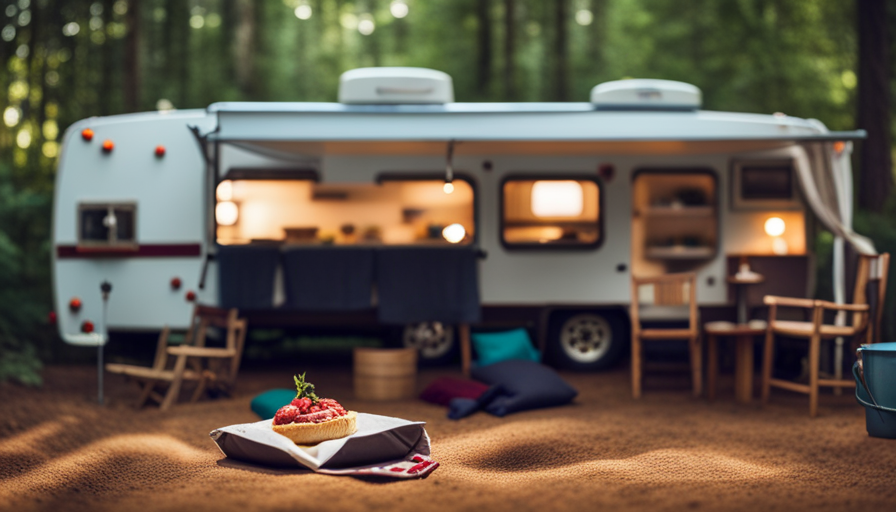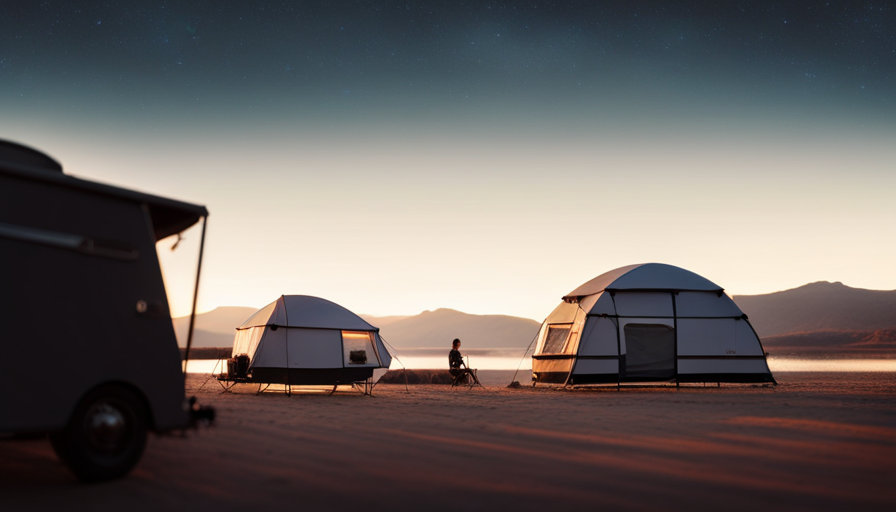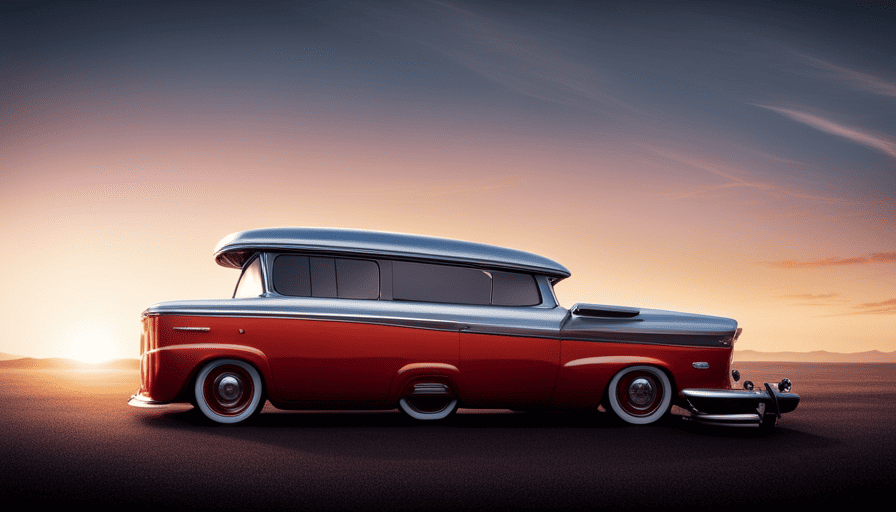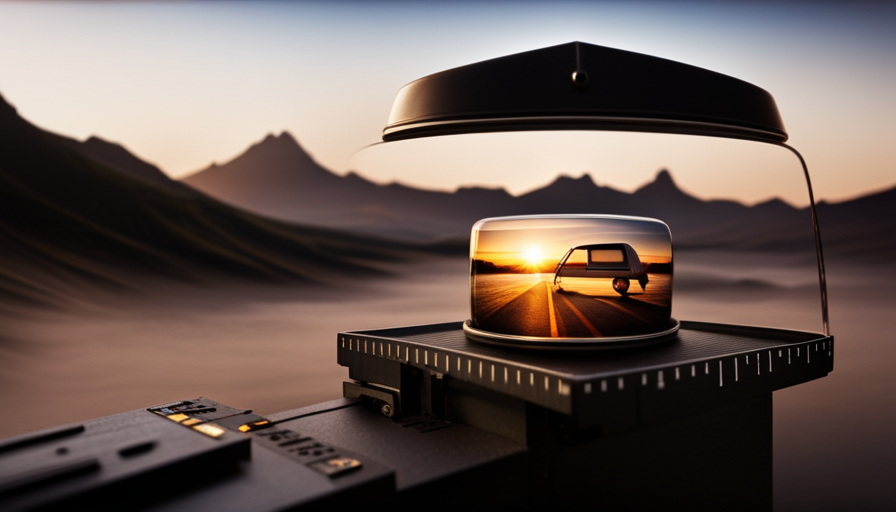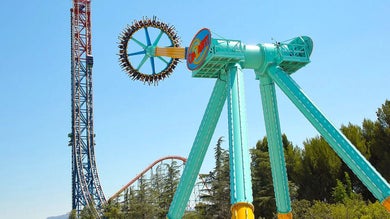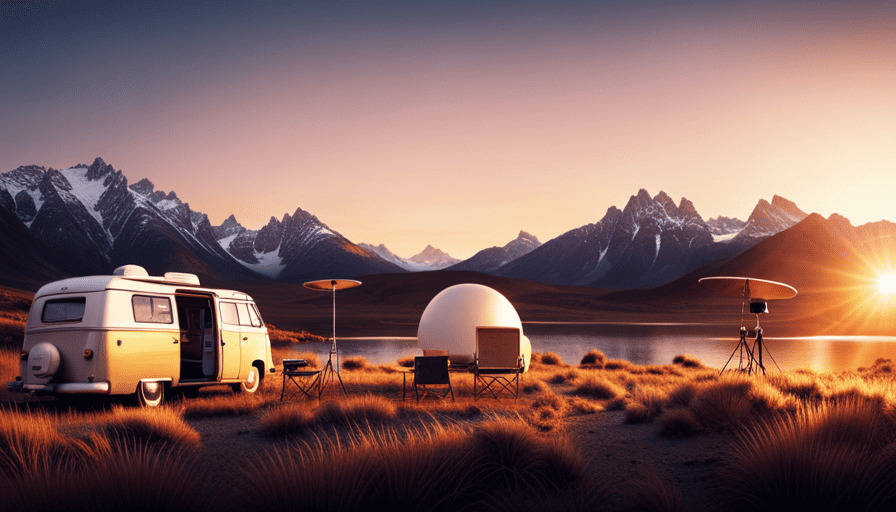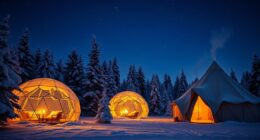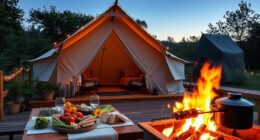Picture a snug mobile cabin, akin to a turtle’s protective shell, that unfolds to unveil a cozy living area. This is what a pop-up camper is all about.
It’s a versatile and convenient option for outdoor enthusiasts who want to experience the joys of camping without sacrificing comfort.
In this article, we will explore the definition, features, and types of pop up campers. We will also discuss the benefits of owning one, as well as the set up and take down process. Maintenance and care tips will be provided to ensure your pop up camper stays in top shape. Additionally, we will delve into the world of accessories and upgrades that can enhance your camping experience.
For those who are not ready to commit to owning a pop up camper, we will explore rental options.
Lastly, we will provide tips on choosing the right pop up camper and discuss the vibrant pop up camper community and resources available.
So, let’s dive in and discover the wonderful world of pop up campers!
Key Takeaways
- Pop-up campers are versatile and convenient options for outdoor enthusiasts, offering collapsible walls and a lightweight design.
- They come in various sizes and layouts, accommodating different numbers of beds and living space, and offering amenities like kitchens and bathrooms.
- Pop-up campers are cost-effective options with lower purchase price, reduced operating costs, and lower maintenance costs compared to larger RVs.
- Joining a pop-up camper community provides access to helpful resources, fosters a sense of camaraderie, and offers opportunities for activities and discounts.
Definition and Features of a Pop Up Camper
A pop-up camper is a versatile and compact recreational vehicle that’s perfect for adventurous travelers. It is a type of camper that has collapsible walls and a roof that can be raised or lowered, allowing for easy setup and storage.
Pop-up campers are known for their lightweight design, making them easy to tow and maneuver on the road. They come in various sizes and layouts, offering different sleeping arrangements and amenities to accommodate different needs.
Owning a pop-up camper has many benefits. Firstly, it provides a comfortable and convenient way to enjoy the great outdoors. With features like beds, a kitchenette, and a dining area, it offers the comforts of home while being surrounded by nature. Additionally, pop-up campers are more affordable compared to larger RVs, making them a cost-effective option for those who want to experience the camping lifestyle without breaking the bank.
When it comes to types of pop-up campers, there are several options to choose from. Some have basic amenities, while others are equipped with luxurious features like air conditioning and a bathroom. The different types cater to various camping preferences, ensuring that there is a perfect fit for every adventurer.
So, let’s dive into the world of pop-up campers and explore the different types available.
Types of Pop Up Campers
One interesting statistic about the different types of pop up campers is that over 70% of them are equipped with a small kitchenette area. This feature allows campers to easily prepare meals while on the go, making their camping experience more convenient and enjoyable.
Pop up campers come in various sizes, ranging from compact models that can comfortably accommodate two people to larger ones that can sleep up to eight individuals. The size of the camper determines the number of beds and the overall living space available.
Additionally, pop up campers offer a variety of features such as storage compartments, dining areas, and even bathrooms with portable toilets and showers. These features provide campers with the comfort and convenience of a home away from home. Some pop up campers also include amenities like air conditioning and heating systems, allowing for comfortable camping in any weather condition.
In the next section, we’ll explore the benefits of owning a pop up camper, including the flexibility and affordability it offers.
Benefits of Owning a Pop Up Camper
Owning a pop up camper offers several benefits that make it a great choice for camping enthusiasts like us. Firstly, pop up campers are more affordable compared to traditional campers, making them a budget-friendly option for those looking to enjoy the camping experience without breaking the bank.
Secondly, they offer easy towing and maneuverability, allowing us to navigate through different terrains with ease.
Lastly, pop up campers are versatile and suitable for various camping environments, whether it’s a weekend getaway in the mountains or a beachside retreat.
Overall, owning a pop up camper provides us with an affordable, convenient, and adaptable camping experience.
Affordability Compared to Traditional Campers
Compared to traditional campers, you’ll be surprised how much more affordable a pop-up camper is. Here are three reasons why pop-up campers are cost-effective options:
-
Lower Purchase Price: Pop-up campers are generally cheaper to buy than traditional campers. With their basic structure and fewer amenities, they offer a budget-friendly alternative for those who want to experience the joy of camping without breaking the bank.
-
Reduced Operating Costs: Pop-up campers are lightweight and have a smaller footprint, which means they require less fuel to tow. Additionally, their compact size allows for easier storage, saving you money on rental fees for storage facilities.
-
Lower Maintenance Costs: Pop-up campers have simpler designs and fewer complex systems compared to traditional campers. This translates into lower maintenance and repair costs over time.
With their affordability comparison and cost-effective options, pop-up campers are an attractive choice for budget-conscious campers. Plus, they offer easy towing and maneuverability, making them even more convenient for your camping adventures.
Easy Towing and Maneuverability
Imagine effortlessly gliding through winding roads and narrow trails as you explore the great outdoors with a compact and agile companion by your side. That’s the experience you can have with a pop-up camper.
One of the main advantages of a pop-up camper is its easy towing and maneuverability. These campers are designed to be lightweight, making them a breeze to tow with a wide range of vehicles. Whether you have a small SUV or a compact car, you can easily tow a pop-up camper without feeling weighed down.
Additionally, pop-up campers offer compact storage when not in use. They can be collapsed down to a smaller size, allowing for easy storage in a garage or driveway. This makes them a convenient option for those with limited storage space.
With their easy towing and compact storage, pop-up campers are a versatile choice for different camping environments. Whether you’re exploring national parks or setting up camp at a local campground, a pop-up camper can accompany you on your adventures.
Versatility for Different Camping Environments
Experience the freedom and flexibility to explore a variety of camping environments with a pop-up camper. It offers you the opportunity to create unforgettable memories in breathtaking locations.
Pop-up campers are designed to be versatile, allowing you to easily adapt to different camping conditions and terrains. These campers are equipped with various features that make them suitable for different camping locations. They’re compact and lightweight, making them easy to tow and maneuver, even in tight spaces.
Additionally, pop-up campers often come with built-in amenities such as a kitchenette, sleeping quarters, and storage space, making them a convenient choice for camping trips.
Whether you prefer camping in the mountains, by the beach, or in the woods, a pop-up camper provides the flexibility to enjoy the great outdoors in comfort.
Now, let’s dive into the set up and take down process.
Set Up and Take Down Process
When setting up your pop-up camper, you’ll be amazed at how quickly and easily the process can be, allowing you to start enjoying your camping adventure in no time. Here are some set up tips and a packing checklist to ensure a smooth experience:
- Start by leveling the camper. Make sure the ground is stable and use leveling blocks if necessary.
- Extend the camper’s main frame and raise the roof. This can usually be done with a few simple cranks or lifts.
- Secure the corners of the camper with stabilizing jacks to add stability and prevent any wobbling.
Next, let’s talk about the packing checklist. It’s important to have all the essentials for a comfortable camping trip:
- Bedding and pillows: Bring sleeping bags or blankets for a good night’s sleep.
- Cooking equipment: Pack a portable stove, pots, pans, and utensils for cooking meals.
- Camping chairs and table: Don’t forget to bring comfortable seating options for relaxing outdoors.
With these set up tips and packing checklist, you’ll be ready to enjoy your camping adventure. Now, let’s move on to maintenance and care tips to keep your pop-up camper in great condition.
Maintenance and Care Tips
To keep your pop-up camper in great condition, it’s important to regularly maintain and care for it. By following some simple maintenance tips and care guidelines, you can ensure that your camper stays in top shape for years to come.
Firstly, it’s crucial to inspect the canvas and seams of your pop-up camper regularly. Look for any signs of wear or damage, such as tears or holes, and repair them promptly to prevent further issues. Additionally, make sure to clean the canvas regularly with mild soap and water to remove dirt and debris.
Next, pay attention to the roof and its seals. Check for any cracks or leaks and reseal them as needed. It’s also important to clean the roof regularly to prevent the buildup of dirt and debris.
Don’t forget about the mechanical components of your pop-up camper. Lubricate the moving parts, such as the lift system and hinges, to ensure smooth operation. Additionally, check the tires, brakes, and electrical system regularly to ensure they’re in good working condition.
By following these maintenance tips and care guidelines, you can keep your pop-up camper in excellent condition. Now, let’s move on to explore some popular pop-up camper brands and what sets them apart.
Popular Pop Up Camper Brands
One of the most well-known and reputable brands in the world of pop-up campers is Jayco. They offer a wide range of models with innovative features and durable construction. Jayco pop-up campers are known for their quality craftsmanship and attention to detail. They’re designed to provide comfort and convenience while on the road, making them a popular choice among camping enthusiasts.
Here are five popular pop-up camper brands that are worth considering:
-
Forest River: Known for their spacious interiors and modern designs, Forest River pop-up campers offer plenty of storage space and comfortable sleeping areas.
-
Coachmen: Coachmen pop-up campers are known for their lightweight construction and easy setup. They’re perfect for those who want a hassle-free camping experience.
-
Starcraft: Starcraft pop-up campers are known for their durability and versatility. They’re designed to withstand the elements and provide a comfortable camping experience.
-
Coleman: Coleman pop-up campers are known for their affordable prices and user-friendly features. They’re a great option for those on a budget.
-
Viking: Viking pop-up campers are known for their compact size and lightweight design. They’re easy to tow and maneuver, making them a popular choice for first-time campers.
Owning a pop-up camper has many benefits, such as the ability to travel and camp in comfort, the convenience of having your own portable living space, and the opportunity to connect with nature.
In the next section, we’ll discuss accessories and upgrades for pop-up campers.
Accessories and Upgrades for Pop Up Campers
If you’re looking to enhance your camping experience, you’ll be amazed at the wide variety of accessories and upgrades available for your pop-up camper. These accessories can make your camping trips more comfortable, convenient, and enjoyable.
From awnings and screen rooms to bike racks and storage solutions, there are countless options to choose from. Some popular accessories for pop-up campers include leveling blocks, stabilizer jacks, and propane tank covers. These items can help you level your camper, stabilize it, and protect your propane tanks from damage.
Other popular upgrades for pop-up campers include solar panels, LED lighting, and upgraded mattresses. Solar panels can provide you with a renewable source of energy, while LED lighting can save battery power and provide better visibility at night. Upgraded mattresses can offer better comfort and support for a good night’s sleep.
When it comes to accessories and upgrades, the best ones for your pop-up camper will depend on your personal preferences and camping needs. So, if you’re looking to take your camping experience to the next level, consider investing in some of these accessories and upgrades. They can truly enhance your camping experience and make it more enjoyable.
Now, let’s move on to the next section about pop-up camper rental options.
Pop Up Camper Rental Options
When considering the benefits of renting a pop up camper, there are a few key points to keep in mind. Firstly, renting allows for flexibility and affordability, as you can choose the duration of your rental and find a camper that fits your budget.
Secondly, there are various rental companies and platforms that offer a wide selection of pop up campers to choose from, ensuring that you can find one that meets your specific needs and preferences.
Lastly, renting a pop up camper allows you to experience the joys of camping without the hassle of owning and maintaining your own camper.
Benefits of Renting a Pop Up Camper
Renting a pop-up camper offers numerous benefits, such as providing a cozy and comfortable camping experience without the hassle of towing a large RV. One of the main advantages is the affordability. Pop up camper rental prices are typically much lower than purchasing one, making it a cost-effective option for those who want to experience the joys of camping without breaking the bank.
Additionally, renting allows you to try out different models and layouts before deciding to buy, ensuring that you find the perfect fit for your needs. Another benefit is the convenience. Rental companies and platforms make it easy to find and book a pop-up camper, often offering delivery and set-up services. This eliminates the need to worry about towing and setting up the camper, allowing you to focus on enjoying your camping trip.
Rental Companies and Platforms
Looking to embark on your camping adventure? Look no further than rental companies and platforms, where a world of outdoor possibilities awaits you.
Rental companies and platforms offer a convenient and affordable way to experience the joys of camping in a pop-up camper. One of the advantages of renting from these companies is the flexibility in rental prices. Prices can vary based on the size of the camper, the duration of the rental, and the time of year.
Additionally, most rental companies and platforms provide customer reviews, allowing you to gain insight into the experiences of previous renters. Reading these reviews can help you make an informed decision and choose the right pop-up camper for your needs.
So, let’s dive into some tips for choosing the right pop-up camper that’ll make your camping trip unforgettable.
Tips for Choosing the Right Pop Up Camper
To find the perfect pop up camper for you, start by considering the size and weight that will best suit your needs. Take into account how many people will be using the camper and how much storage space you require. Additionally, think about the type of vehicle you have and its towing capacity. Once you have determined the size and weight, you can move on to other important factors when choosing a pop up camper.
-
Features: Look for a pop up camper that has the features you desire. This could include amenities such as a kitchenette, bathroom, or air conditioning. Consider what’s essential for your camping experience and prioritize those features.
-
Durability: Check the construction and materials used in the pop up camper. Look for high-quality components that’ll withstand the elements and provide longevity.
-
Price: Set a budget and stick to it. Compare prices of different pop up campers using a pop up camper buying guide or a pop up camper comparison chart. This’ll help you find the best value for your money.
When it comes to choosing the right pop up camper, these tips’ll help you make an informed decision. Once you’ve found the perfect camper, you can explore the pop up camper community and resources to enhance your camping experience.
Pop Up Camper Community and Resources
When it comes to being a part of the pop-up camper community, there are several resources available to us.
Online forums and communities provide a platform for us to connect with other pop-up camper enthusiasts, share tips and advice, and ask questions.
Camping clubs and gatherings offer opportunities to meet fellow pop-up camper owners in person, participate in group activities, and learn from experienced campers.
Additionally, there are maintenance and troubleshooting resources available to help us keep our pop-up campers in top shape and address any issues that may arise.
Online Forums and Communities
Join the online forums and communities to connect with fellow pop-up camper enthusiasts and gain valuable insights into the world of camping. These online discussions provide a platform for advice sharing, where experienced campers can offer tips and tricks to newbies.
The forums allow you to ask specific questions about maintenance, repairs, and modifications, and receive helpful responses from knowledgeable members. Additionally, you can find resources such as camping checklists, campground recommendations, and even recipes for delicious campfire meals.
The communities are a great place to share your own experiences and photos, inspiring others and fostering a sense of camaraderie among campers. By participating in these forums, you’ll expand your knowledge and connect with like-minded individuals who share your passion for pop-up campers. Transitioning into camping clubs and gatherings, you can take your love for camping to the next level.
Camping Clubs and Gatherings
Participating in camping clubs and gatherings can provide an enriching experience, allowing us to connect with fellow outdoor enthusiasts and create lasting memories in the great outdoors. Camping events organized by these clubs offer a wide range of activities, from group hikes and fishing trips to campfire storytelling and cooking competitions.
By joining a camping club, we gain access to a community of like-minded individuals who share our passion for camping and adventure. This not only opens up opportunities to learn from experienced campers but also provides a support system when planning future trips. Additionally, camping clubs often offer discounts on camping gear and access to exclusive campgrounds, making our camping experience more affordable and convenient.
Transitioning into the next section, maintenance and troubleshooting resources, we can rely on these clubs and gatherings to provide valuable advice and tips for keeping our pop-up campers in top shape.
Maintenance and Troubleshooting Resources
When it comes to owning a pop-up camper, it’s important to know how to properly maintain and troubleshoot any issues that may arise. Luckily, there are plenty of resources available to help us navigate through these tasks.
From online forums and websites to instructional videos and user manuals, we have a wealth of information at our fingertips.
One of the first steps in maintaining a pop-up camper is to regularly inspect and clean it. This includes checking for any signs of wear and tear, such as leaks or damaged seals, and addressing them promptly. Additionally, it’s crucial to keep up with routine maintenance tasks, such as checking and greasing the bearings, inspecting the tires for proper inflation and wear, and ensuring all electrical connections are in good working order.
When it comes to troubleshooting common issues, such as a malfunctioning lift system or a faulty electrical component, it’s helpful to consult online resources or reach out to fellow pop-up camper owners for advice. By staying proactive and knowledgeable about maintenance tips and common issues, we can ensure that our pop-up camper stays in great shape for years to come.
Frequently Asked Questions
What are the different types of towing vehicles that can safely tow a pop up camper?
When it comes to towing a pop-up camper, there are several types of vehicles that can safely handle the job. From compact SUVs to full-size trucks, the options are varied.
Each type has its own set of pros and cons. Compact SUVs offer better fuel efficiency and easier maneuverability, while full-size trucks provide more towing capacity and stability.
It’s important to consider factors such as weight limits, trailer hitch compatibility, and overall towing capabilities when choosing the right vehicle for your pop-up camper.
Are there any weight restrictions for pop up campers when it comes to loading them with gear and supplies?
Weight restrictions for pop up campers vary depending on the specific model and manufacturer. It’s crucial to consult the owner’s manual or contact the manufacturer for the exact weight limits.
Overloading a pop up camper can compromise its stability and towing safety. To properly secure gear and supplies, distribute the weight evenly and place heavier items closer to the floor. Utilize straps, bungee cords, and cargo nets to secure items in place and prevent shifting during travel.
How long does it typically take to set up and take down a pop up camper?
Setting up and taking down a pop-up camper can typically take around 15-30 minutes, depending on experience and preparation.
It involves unfolding the camper, extending the supports, and securing the canvas walls and roof.
Taking it down requires collapsing the supports, folding the canvas, and packing everything back into its designated storage compartments.
Proper organization and familiarity with the process can greatly reduce the time it takes to set up and take down a pop-up camper.
What are some common maintenance tasks that need to be done regularly to keep a pop up camper in good condition?
Common maintenance tasks for a pop up camper include cleaning and waterproofing the canvas to prevent mold and mildew growth. Checking and maintaining the electrical system for any issues or damage. Inspecting and servicing the brakes and tires to ensure safe towing. Regularly checking for any water leaks or damage that may occur. These tasks are essential to keeping a pop up camper in good condition and ensuring a safe and enjoyable camping experience.
Are there any specific safety precautions or tips to keep in mind while using a pop up camper, especially during extreme weather conditions?
Tips for securing a pop up camper during high winds include using stabilizing jacks to prevent swaying, securing the awning with straps or bungee cords, and using additional tie-downs for added stability.
To properly waterproof a pop up camper, check for leaks or cracks in the roof, windows, and seams. Use waterproof sealant or tape to fix any issues and ensure a watertight seal.
Regularly inspect and maintain the camper’s exterior to prevent water damage.
What Are The Key Differences Between a Pickup Camper and a Pop Up Camper?
When it comes to pickup camper information, understanding the key differences between a pickup camper and a pop up camper is essential. A pickup camper is a self-contained unit that is permanently mounted on a truck bed, whereas a pop up camper is collapsible and can be towed behind a vehicle. Both offer unique benefits and amenities, making it important to consider the specific needs and preferences before choosing one.
Conclusion
In conclusion, after conducting thorough research and investigation, it’s clear that pop up campers are a versatile and convenient option for camping enthusiasts.
With their unique features and types, pop up campers offer a comfortable and compact living space while allowing for easy transportation.
The benefits of owning a pop up camper are numerous, from the simple set up and take down process to the affordable maintenance and care.
Additionally, the availability of various accessories and upgrades enhances the camping experience.
Whether you choose to rent or buy, joining the vibrant pop up camper community offers valuable resources and support.

